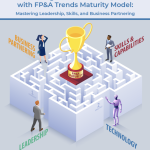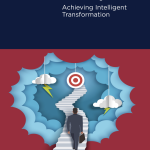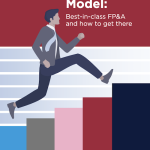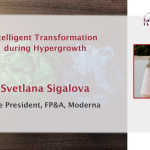This paper explores the What, Why, and How of Intelligent Transformation, emphasising three interpersonal...

Today, we're seeing a shift in the Financial Planning and Analysis (FP&A) market. As the recent FP&A Trends Maturity Model describes, organisations feel pressured to mature their planning process and arm their teams to partner across the business. While many companies wonder where to start, others have initiated that journey, embracing technology to enable this change.
Technology changes how people work today. But what are those key capabilities enabling transformation, and how are companies using them to get where they need to be?
In this article, we are looking at the technology's potential that FP&A professionals can leverage for Intelligent Transformation.
What Does Technology Offer for Handling Your Data?
The central element of all that technology provides and where platforms add value is data. Critical technological capabilities provided by modern technological advancements can help FP&A professionals handle data in a way that manual processes cannot. Those capabilities encompass:
Cloud and Analytics
We have seen the explosion of data over a decade ago and how it exponentially grows. The move to the cloud has allowed platforms and applications to control and organise that data. We have also seen a lot of improvements around analytics capabilities and generative Artificial Intelligence, which allows us to augment the insights we get out of that data.
Storytelling
Another critical aspect is to be able to consume the data we have. Technology has developed tools to visualise it better. Quick dashboarding, as such, has limited value. But today, EPM tools go beyond BI, as they offer more flexibility. For instance, they can interrogate the data to support FP&A professionals in shaping their stories. Now, FP&A teams can truly partner with business functions by articulating the financial impact of the company's strategic initiatives.
Connectivity and Automation
They have been key parts of software development for a long time. Today, most platforms offer the possibility to connect seamlessly to any system. The data comes in real-time, and teams can set up granular and complex workflows that take over manual, non-value-added work, such as data collection, review, and validation. This creates an overall stronger process that provides greater confidence in the accuracy of the data presented.
Intelligence
Intelligent platforms can connect data at all levels, not only hierarchically (strategic to operational, which are internal data elements) but also connect to a wider network of data that the company may have limited influence on but will be impacted by. Taking a broader scope of drivers allows us to get a more accurate predictive analysis. Beyond better forecasting of an individual event or transaction, this also set companies to become more responsive to opportunities and disruptions.
Why Opting for Intelligent FP&A Transformation: Toyota's Case
Many organisations have gone through the process of change and today operate much more effectively. A great example is how Toyota Motor Europe moved from spreadsheet-based budgeting and forecasting processes to create a standardised approach across 40 of their companies within the group1.
Their challenge was Excel-based budgets and forecasts, with different processes for each business branch. The consolidation was nightmarish and error-prone, and they spent hours checking data. The company initiated a digital transformation project to create a unified approach.
In order to foster a transition from traditional to intelligent planning, they made some key changes to their process, empowered by technology. Changes covered connecting systems, bringing data together, building standard processes and automating manual tasks. Another key element was the ability to customise. Technology today offers a degree of agility that desktop tools don't.
"The key feature we wanted was templates that facilitated quick and agile collection of data," says Jordan Rowley, Project Manager at Toyota Motors Europe. "We didn't want an extensive, elaborate template that would be a burden to users. We've implemented collection templates specific to companies and processes that are really easy for the users to see, which are based on their own feedback."
This has created transparency and a real-time understanding of the real contribution of each product.
If you don't know how to start such an initiative, the FP&A Trends Maturity Model can help you. It offers benchmarks and a roadmap to Intelligent Transformation.
How to Leverage the Potential of AI/ML in FP&A
Leveraging the potential of Artificial Intelligence/Machine Learning in FP&A requires a strategic blend of innovation and precision. Integrating AI/ML into Financial Planning and Analysis (FP&A) empowers businesses to forecast unprecedentedly, identify hidden patterns within data, and streamline complex decision-making processes.
While many CFOs are facing input price inflation and profitability pressure, leading organisations in every industry invest in digital capabilities and harnessing AI/ML algorithms to optimise resources, costs and improve decisions around profitability.
Some examples include:
- Using AI/ML algorithms for demand sensing and pricing optimisation combined with Scenario Management allows the FP&A team of a global consumer goods business to assess and manage profitability effectively across multiple distribution channels and product ranges.
- A global fashion retailer uses AI/ML algorithms to optimise their assortment across online and physical stores, enabling FP&A teams to control inventory costs and improve profitability while ensuring a better customer experience.
EPM platforms are also investing in generative AI. Generative AI can help with day-to-day activities, automating simple processes such as:
Auto-Generated Data Analysis
It can ease day-to-day activities in the same way as ChatGPT is used for content creation. We ask the assistant to load a data set and generate their analysis. Artificial Intelligence will provide insights such as trends, top performers, or year-on-year comparisons in seconds.
Dashboard Creation
Generative AI can also facilitate this. Instead of inserting tables or graphics manually, we type the request and let technology handle the design. The analysis can be refined by emphasising key findings until we get the visual wanted.
Automated Forecasting
Finally, generative models can automate AI-based forecasting without the complexity and knowledge that is typically required. By asking our assistants to feed historical data into predictive forecasting algorithms, we can enable them to learn and simulate various scenarios based on different variables, returning our desired spectrum of possibilities for future trends, market shifts, and financial scenarios.
Final Thoughts
These examples outlined above are fairly new and not widely used today. But they are now under the radar of modern platforms. We have to admit it will take time to adopt these capabilities and learn how to truly use them at their full potential. But we need to consider and balance a couple of elements and how they apply to each organisation:
- There is a time for technology development as the software requires a certain number of iterations to fine-tune its offering and articulate its value for users. There is a learning curve for everyone. In this context, evaluating future-proofing is essential when partnering with software companies. What they have to offer today is as important as what they will be able to offer tomorrow.
- On the other hand, it is widely accepted that AI/ML is set to change how people work. It creates necessary process efficiencies that are too often overlooked but have a financial impact. The companies that will embrace these changes early on will also be the ones that will benefit the most. Early adopters will always stay ahead of the competition.
References:
- "Pan-European Planning and Reporting at Toyota Motor Europe." Board. Accessed December 12, 2023. https://www.board.com/en/case-study/pan-european-planning-reporting-toyota-motor-europe.
Subscribe to
FP&A Trends Digest

We will regularly update you on the latest trends and developments in FP&A. Take the opportunity to have articles written by finance thought leaders delivered directly to your inbox; watch compelling webinars; connect with like-minded professionals; and become a part of our global community.






